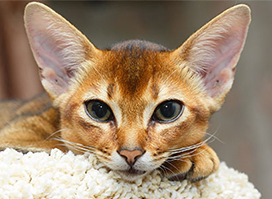Renal Amyloidosis
 Feline kidneys—two bean-shaped little organs situated just behind the rib cage, one on each side of a cat’s spine—play a vital role in carrying out many of an animal’s life-sustaining bodily processes. Among the most important of these processes is the removal of metabolic waste products, such as urea, mineral salts, and potentially harmful substances from circulating blood. This is accomplished by tissue containing hundreds of thousands of tiny filtration units called nephrons. When waste-laden blood enters the kidneys via the renal artery, it moves through progressively smaller vessels until it reaches the glomeruli. From the glomeruli, the blood is then transported through structures called renal tubules. In most cases, this filtering process continues smoothly throughout a cat’s lifetime. In rare cases, however, it can be curtailed by a serious and incurable disorder called renal amyloidosis.
Feline kidneys—two bean-shaped little organs situated just behind the rib cage, one on each side of a cat’s spine—play a vital role in carrying out many of an animal’s life-sustaining bodily processes. Among the most important of these processes is the removal of metabolic waste products, such as urea, mineral salts, and potentially harmful substances from circulating blood. This is accomplished by tissue containing hundreds of thousands of tiny filtration units called nephrons. When waste-laden blood enters the kidneys via the renal artery, it moves through progressively smaller vessels until it reaches the glomeruli. From the glomeruli, the blood is then transported through structures called renal tubules. In most cases, this filtering process continues smoothly throughout a cat’s lifetime. In rare cases, however, it can be curtailed by a serious and incurable disorder called renal amyloidosis.
In this condition, abnormal amounts of a fibrous protein substance (amyloid) collect—for unknown reasons—in otherwise healthy kidney tissue. As the presence of this mysterious foreign substance increases, says Richard Goldstein, DVM, associate professor of small animal medicine at Cornell University’s College of Veterinary Medicine, “It causes the gradual displacement of normal, healthy, viable kidney tissue.”
Consequently, the kidneys become unable to function properly. The kidney tissue will become inflamed, and the affected cat will pass increasing amounts of valuable protein in its urine—including proteins responsible for the prevention of blood clotting in the body and the accumulation of fluid in the abdomen and limbs. An affected cat will also lose its ability to filter toxic waste products, such as urea, from the blood.
Most of the clinical signs of renal amyloidosis, notes Dr. Goldstein, are similar to those associated with serious kidney diseases in general—increased drinking and excessive urination; diminished appetite and weight loss; swollen limbs; and vomiting. “However,” he points out, “in cats with other types of chronic renal disease, we typically see small, shrunken kidneys. With amyloidosis, the kidneys will remain normal in size—and that will be a tip-off.”
Diagnostic measures will include a complete blood count and blood chemistry panel, urinalysis, x-rays, and ultrasound imaging. In addition, a definitive diagnosis will require a biopsy. Because a sample of an ailing cat’s kidney tissue will appear normal to the naked eye, Dr. Goldstein notes, the tissue must be stained with a special dye that will reveal any areas affected by amyloid deposits. “We don’t know how to reverse amyloid development in cats once it has started,” he says. “So the prognosis is not good. We do, however, have medicines and dietary therapies that may slow the process down if it’s recognized at an early stage.”
In general, renal amyloidosis is a rare condition, and its specific causes remain unknown, although genetic heritability certainly appears to play a role. When the condition is diagnosed, Dr. Goldstein notes, the patient is almost always an Abyssinian cat, although the condition also occurs with disproportionate frequency in Oriental breeds. Accordingly, he recommends the following: “If you have an Abyssinian cat, you should have bloodwork done at least once a year when it’s young and twice a year when it’s older. If the condition is recognized at an early stage, you’ll at least be allowing time to slow down the pace of its development.”



